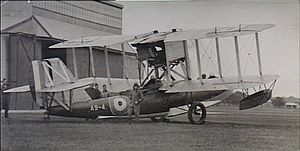Supermarine Seagull III
| Seagull | |
|---|---|
 |
|
| Australian Seagull III at RAAF Base Richmond circa. 1928 | |
| Role | Reconnaissance flying boat |
| Manufacturer | Supermarine |
| First flight | May 1921 |
| Primary users |
Fleet Air Arm Royal Australian Air Force |
| Number built | 34 |
| Developed from | Supermarine Seal |
The Supermarine Seagull was a British amphibian biplane flying boat developed from the Supermarine Seal by the Supermarine company. The Seagull was constructed of wood. The lower wing was set in the shoulder position and had two bays. The engine was mounted in a nacelle slung from the upper wing and powered a four-blade propeller in tractor configuration. The fuselage had an oval cross-section and had a planing bottom with two steps.
The prototype, which became known as the Seagull Mk I, was modified from an existing Supermarine Seal II in 1921. Only one aircraft was built. A Napier Lion II engine was fitted and there were modifications made to the nacelle.
Produced from 1922, the production aircraft, the Seagull Mk II, had a Napier Lion III engine, and these were supplied to the Air Ministry and Royal Navy. A total of 25 were built, although some of these were later modified.
The Seagull Mk III was the Australian version, built in 1925. These were similar to the Seagull II but with a Napier Lion V engine and radiators modified for tropical use. Six of these were supplied to the Royal Australian Air Force (or Navy? The Upper Hutt New Zealand City Library's "Recollect" collection has a photograph of a Seagull on HMAS Australia); one other Seagull III was built for Japan.
One Seagull II was rebuilt and fitted with Handley-Page leading edge slots and twin fins and rudders in 1928. This was considered to be the Mark IV, although Supermarine never designated it as such. Three ex-service aircraft were later placed on the British Civil Register.
...
Wikipedia
